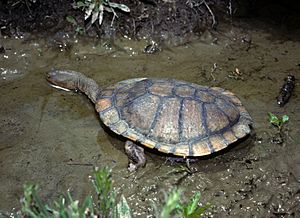Eastern long-necked turtle facts for kids
Quick facts for kids Eastern long-necked turtle |
|
|---|---|
 |
|
 |
|
| Ventral view of female | |
| Conservation status | |
| Scientific classification | |
| Genus: |
Chelodina
|
| Species: |
longicollis
|
| Synonyms | |
|
|
The eastern long-necked turtle (Chelodina longicollis) is a special type of turtle found in eastern Australia. It lives in many different watery places like ponds and rivers. This turtle is called a "side-necked" turtle because it bends its long neck sideways to tuck its head into its shell, instead of pulling it straight back like other turtles. It's also known as a "snake-necked turtle" because of its long, snake-like neck! These turtles are always looking for food and will eat whatever they can find.
Contents
Where Do Eastern Long-necked Turtles Live?
You can find these turtles all over southeastern Australia. They live from west of Adelaide in South Australia, all the way east through Victoria and New South Wales. They also live north up to the Fitzroy River in Queensland. Sometimes, these turtles meet another type of snake-necked turtle called Chelodina canni. When they do, they can have babies together, which are often very strong and healthy.
What Do Eastern Long-necked Turtles Look Like?
The top part of this turtle's shell, called the carapace, is usually black. Some turtles might have a brown shell instead. It's wide and flat, with a noticeable groove down the middle. The bottom part of the shell, called the plastron, is wide and creamy yellow. Its edges are often outlined in black.
The neck of the eastern long-necked turtle is very long and thin. It can be about 60% as long as its shell! The neck has many small, bumpy spots and is grey or black on top, with a creamy color underneath. Their narrow heads are also grey or black. Female turtles usually grow bigger and have deeper bodies than males. The size they reach can depend on where they live and how much food is available. For example, turtles living in the Murray River area tend to be larger than those in the Latrobe Valley.
When this turtle feels scared or threatened, it can let out a stinky fluid from special glands. This is why some people call it the "stinker" turtle!
Eastern long-necked turtles are carnivores, meaning they eat meat. Their diet includes many different small animals. They love to eat insects, worms, tadpoles, frogs, small fish, crustaceans (like tiny crabs), and molluscs (like snails).
How Do Eastern Long-necked Turtles Reproduce?
In the early summer, female turtles lay their eggs. They dig a nest in the banks near the water where they live. Each nest can hold between two and ten eggs. About three to five months later, the baby turtles hatch from their shells. These tiny hatchlings are very small and can easily become food for other animals, like fish and birds. A female turtle can lay one to three groups of eggs each year.
Gallery
See also
 In Spanish: Tortuga de cuello de serpiente australiana para niños
In Spanish: Tortuga de cuello de serpiente australiana para niños







